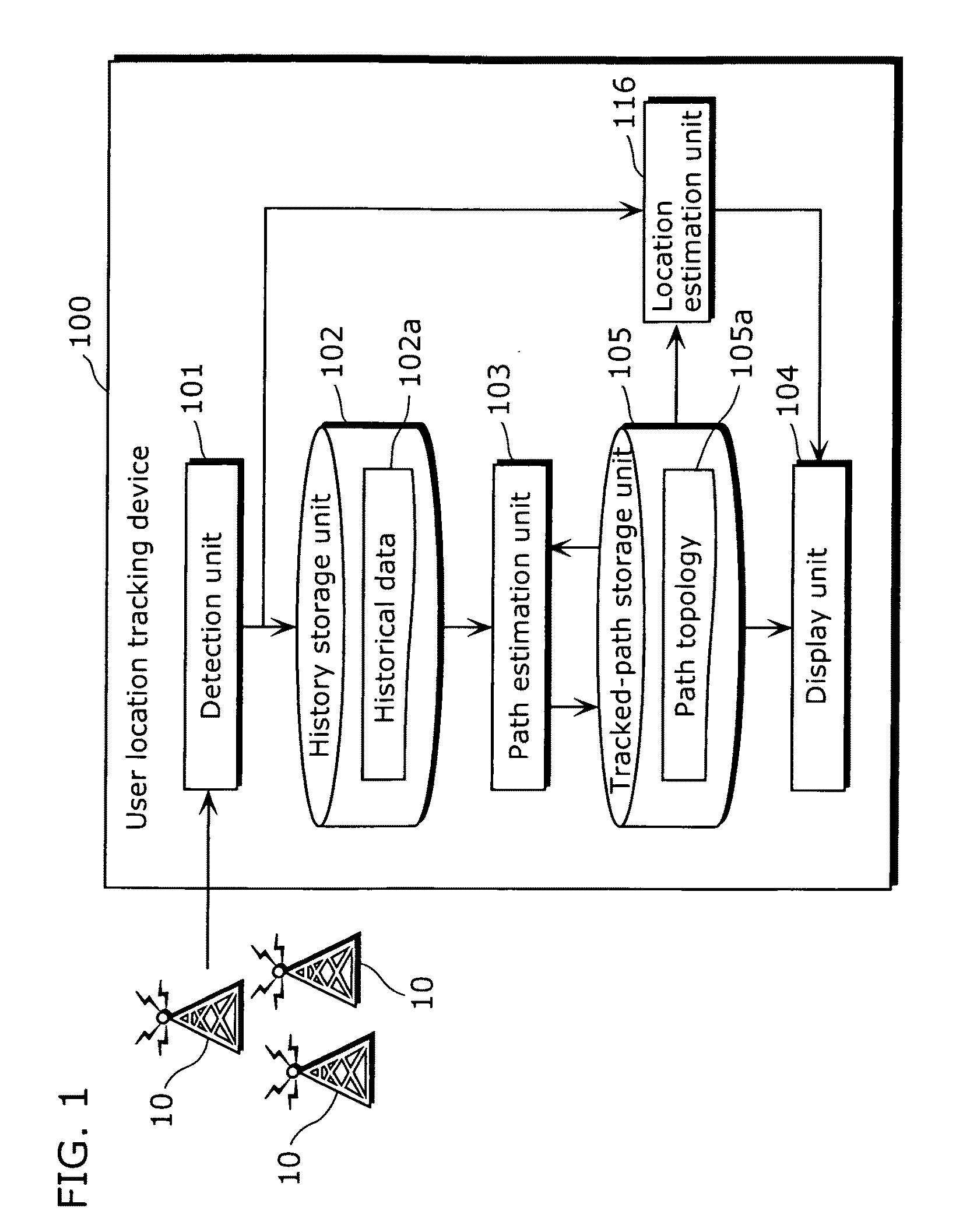Mobility tracking method and user location tracking device
a mobile terminal and location tracking technology, applied in the field of mobile terminal location tracking, can solve the problems of difficult to measure a relative location with respect to the reference point, and cannot be used as a reference point for range-based localization,
- Summary
- Abstract
- Description
- Claims
- Application Information
AI Technical Summary
Benefits of technology
Problems solved by technology
Method used
Image
Examples
first embodiment
[0081]The following is a description of a mobility tracking method according to the first embodiment of the present invention, with reference to the drawings.
[0082]FIG. 1 is a block diagram showing a configuration of a user location tracking device 100 which realizes the mobility tracking method, according to the first embodiment of the present invention.
[0083]Using IEEE 802.11 access points which are ubiquitously available, the user location tracking device 100 tracks the location of a user who owns the user location tracking device 100. As shown in FIG. 1, the user location tracking device 100 includes a detection unit 101, a history storage unit 102, a path estimation unit 103, a tracked-path storage unit 105, a location estimation unit 116, and a display unit 104.
[0084]At a position where the user location tracking device 100, which is a tracking object, is situated, the detection unit 101 receives radio waves sent from ubiquitously available wireless devices 10 and detects whic...
second embodiment
[0121]In the present embodiment, a hidden Markov model (HMM) is used by the path estimation unit 103 for pattern recognition and tracked-path holding. The Tanimoto coefficient is calculated based on the parameters of the observation probability of the hidden Markov model. On account of this, when the same path is traveled over and over again, the amount of calculation can be reduced as compared to the case where the calculation is performed among the historical data sets. It should be noted that components which are not particularly explained in the present embodiment are the same as those shown in FIG. 1.
[0122]More specifically, the tracked path is held as a hidden Markov model in which the location of the user location tracking device 100 is a state variable and the wireless device information detected by the detection unit 101 is an observed variable.
[0123]From the historical data and the hidden Markov models of the tracked paths obtained up to the current time, the deviation jud...
first modification
(First Modification)
[0181]In the above second embodiment, the user location tracking device 100 does not estimate its current location. On the other hand, in the present modification, the user location tracking device 100 estimates its current location using the location estimation unit 116. To be more specific, when the user location tracking device 100 is not deviating from the tracked path, the location estimation unit 116 performs maximum likelihood estimation for estimating the current location of the user location tracking device 100, using the historical data and the hidden Markov models obtained up to the current time.
[0182]FIG. 18 is a flowchart showing processing performed by the path estimation unit 103, according to the first modification of the second embodiment. Note that an explanation regarding the same steps as in the flowchart of FIG. 12, that is, steps S202 to S206 and steps S208 to S220, is omitted here and that only a different step, i.e., step S222, is explaine...
PUM
 Login to View More
Login to View More Abstract
Description
Claims
Application Information
 Login to View More
Login to View More - R&D
- Intellectual Property
- Life Sciences
- Materials
- Tech Scout
- Unparalleled Data Quality
- Higher Quality Content
- 60% Fewer Hallucinations
Browse by: Latest US Patents, China's latest patents, Technical Efficacy Thesaurus, Application Domain, Technology Topic, Popular Technical Reports.
© 2025 PatSnap. All rights reserved.Legal|Privacy policy|Modern Slavery Act Transparency Statement|Sitemap|About US| Contact US: help@patsnap.com



